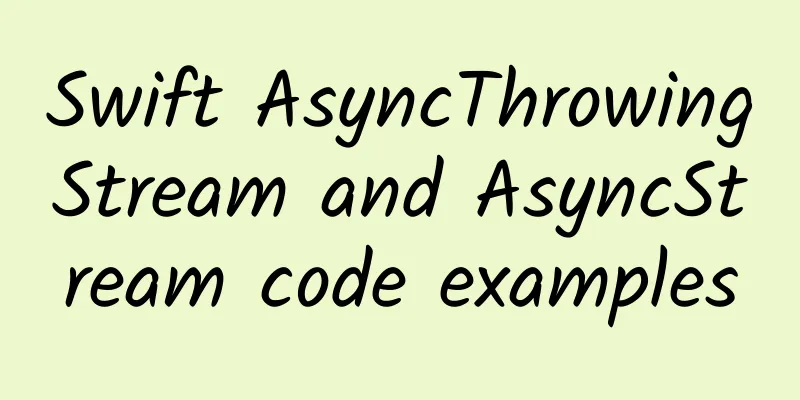Swift AsyncThrowingStream and AsyncStream code examples

PrefaceAsyncThrowingStream and AsyncStream are part of the concurrency framework introduced in Swift 5.5 by SE-314[1]. Asynchronous streams allow you to replace existing code that relies on closures or combine publishers. Before diving into the details around throwing streams, I recommend you read my article covering async-await if you haven’t already. Most of the code explained in this article will use the API explained there. What is AsyncThrowingStream?You can think of an AsyncThrowingStream as a stream of elements that may cause an error to be thrown. Its value is passed over time, and the stream can be closed by an end event. Once an error occurs, the end event can be either success or failure. What is AsyncStream?AsyncStream is similar to the throwing variant, but will never cause an error to be thrown. A non-throwing asynchronous stream completes upon explicit completion or cancellation of the stream. Note: In this article, we will explain how to use AsyncThrowingStream. The code examples are similar to AsyncStream except for the part where error handling occurs. AsyncThrowingStreamHow to use AsyncThrowingStreamAsyncThrowingStream can be a great replacement for existing closure-based code like progress and completion handlers. To better understand what I mean, I'll walk you through a scenario we encountered in the WeTransfer application. In our application, we have an existing closure-based class called FileDownloader: struct FileDownloader { A file downloader accepts a URL, reports progress, and completes with a result containing the downloaded data or an error on failure. A file downloader reports a stream of values as the file download progresses. In this case, it reports a stream of status values to report the current state of the running download. FileDownloader is a perfect example of a piece of code you can rewrite to use AsyncThrowingStream. However, rewriting requires you to rewrite your code at the implementation level as well, so let's define an overloaded method instead: extension FileDownloader { As you can see, we wrapped the download method in an AsyncThrowingStream . We typed the stream's value Status as a generic type, allowing us to continue the stream with status updates. Whenever an error occurs, we complete the stream by throwing an error. In the case of a completion handler, we either complete by throwing an error or follow up the production of data with a non-throwing completion callback. switch result { It is critical not to forget to call the finish() callback after receiving the last status update. Otherwise, we will keep the stream alive and the implementation code will never continue. We can rewrite the above code by using another yield method, accepting a Result enum as a parameter: continuation .yield ( with : result .map { .finished ( $0 ) } ) The rewritten code simplifies our code and removes the switch-case code. We have to map our Reslut enum to match the expected Status value. If we produce a failed result, our flow will end after throwing the contained error. AsyncThrowingStream IterationOnce you have configured your asynchronous throw stream, you can start iterating over the stream of values. In our FileDownloader example, it will look like this: do { We handle any state updates, and we can use the catch closure to handle any errors that occur. You can iterate using the for ... in loop based on the AsyncSequence interface, which is the same for AsyncStream. If you encounter a compilation error like this:
The print statements in the above code example help you understand the life cycle of AsyncThrowingStream. You can replace the print statements to handle progress updates and process data to provide visualization for your users. Debugging AsyncStreamIf a stream fails to report a value, we can debug the callbacks generated by the stream by placing breakpoints. Although it is also possible that the print statement "Download finished and stream closed" above is never called, which means that your code in the implementation layer never continues. The latter may be the result of an unfinished stream. To verify this, we can use the onTermination callback: func download(_ url: URL) -> AsyncThrowingStream<Status, Error> {The callback is called when the stream is terminated, and it will tell you whether your stream is still alive. If an error occurs, the output may look like this: Stream terminated with status finished(Optional(FileDownloader.FileDownloadingError.example)) The above output is only possible when using an AsyncThrowingStream. If it is a normal AsyncStream, the completed output looks like this: Stream terminated with status finished The result of cancellation is the same for both types of streams: Stream terminated with status canceled You can also use this termination callback to do any cleanup after the stream ends. For example, removing any observers or cleaning up disk space after a file has been downloaded. Cancel an AsyncStreamAn AsyncStream or AsyncThrowingStream can be cancelled due to the cancellation of an enclosing task. An example could be as follows: let task = Task . detached { A stream is cancelled when it goes out of scope or when the enclosing task is cancelled. As mentioned before, cancellation will trigger the onTermination callback accordingly. in conclusionAsyncThrowingStream or AsyncStream are a great way to rewrite existing closure-based code to async-await-enabled alternatives. You can provide a continuous stream of values and complete a stream on success or failure. You can iterate over the values at the implementation level using a for loop based on the AsyncSequence APIs. References[1] SE-314: https://github.com/apple/swift-evolution/blob/main/proposals/0314-async-stream.md. |
<<: Microsoft Authenticator for iOS is updated to officially stop supporting Apple Watch
Recommend
Operators shut down 2G/3G: Who will pay for everyone to replace their phones?
As early as two years ago, operators led by China ...
In-depth analysis of information flow, splash screen, and incentive video advertising!
Mobile advertising comes in many forms. For mobil...
This great achievement in the history of mathematics is attributed to the Arabs?
This article briefly introduces the early develop...
JDPOWER's best certified car company overturned, a fuse caused Kia to recall 380,000 cars
Korean cars are becoming less and less visible in...
iOS internal skills: memory management
[[165151]] Preface Now iOS development has entere...
This "magic seasoning" is used by Chinese people to stew meat, but foreigners like to use it as a drink
When the weather gets cold, we can't help but...
Xiaohongshu monetization guide!
Perhaps many people come to Xiaohongshu with the ...
Driving sharing model: the secret to getting users to actively share traffic
Since the Internet traffic dividend began to grad...
How to make a good online event promotion plan?
In marketing psychology, herd mentality, the ment...
How to develop a complete user growth system architecture?
If you learn the right principles in the field of...
College entrance examination score checking starts: 23 provinces can directly search "college entrance examination" on Alipay to check scores and admissions
[[406838]] Two weeks have passed since the 2021 c...
Zhejiang University denies developing invisibility cloak: Theoretically feasible but current technology cannot achieve it
Recently, a video circulated online claimed that ...
Band strategy "Advanced Course of Bidding System" Bidding system automatic stock selection software Tongdaxin permanent version
Band strategy "Advanced Course of Bidding Sy...
The protagonist of this year's Spring Festival, the zodiac, may be a little misunderstood by us...
It's coming! It's coming! The Year of the...
After analyzing the pain points of 100 copywriting articles, we found that 99% of them are not really painful!
I have recently collected some articles about cop...









